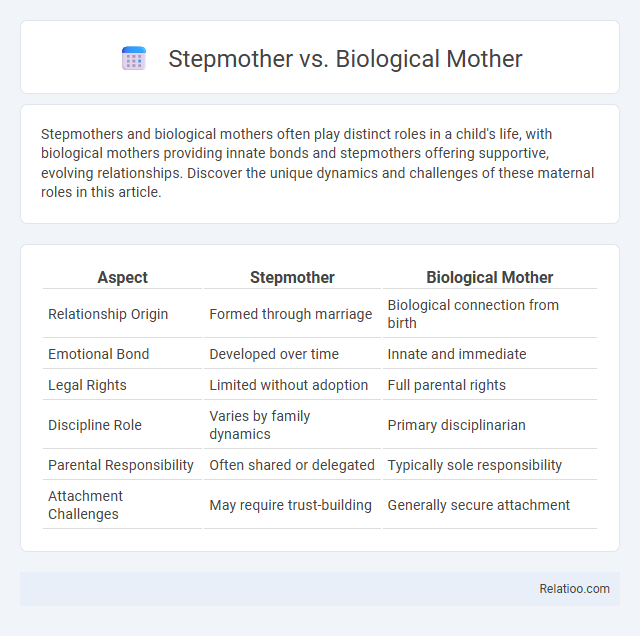Stepmothers and biological mothers often play distinct roles in a child's life, with biological mothers providing innate bonds and stepmothers offering supportive, evolving relationships. Discover the unique dynamics and challenges of these maternal roles in this article.
Table of Comparison
| Aspect | Stepmother | Biological Mother |
|---|---|---|
| Relationship Origin | Formed through marriage | Biological connection from birth |
| Emotional Bond | Developed over time | Innate and immediate |
| Legal Rights | Limited without adoption | Full parental rights |
| Discipline Role | Varies by family dynamics | Primary disciplinarian |
| Parental Responsibility | Often shared or delegated | Typically sole responsibility |
| Attachment Challenges | May require trust-building | Generally secure attachment |
Understanding the Roles: Stepmother vs Biological Mother
Stepmothers and biological mothers fulfill distinct but complementary roles within a family dynamic, where biological mothers provide the primary emotional and biological foundation for a child, while stepmothers often contribute support, stability, and guidance in blended families. Research highlights that successful stepmother relationships depend on clear boundaries, open communication, and mutual respect with both the child and biological mother to foster trust and cohesion. Understanding these roles helps in navigating complex family structures, promoting healthy attachment, and enhancing overall family well-being.
Emotional Bonds: Building Relationships with Children
Emotional bonds between children and mothers, whether stepmothers or biological, differ significantly based on shared experiences and trust development. Biological mothers often establish early attachment through caregiving from birth, while stepmothers build relationships gradually, influenced by acceptance and consistent support. Family roles evolve when stepmothers navigate boundaries, fostering emotional security and nurturing connections that complement biological maternal ties.
Parental Authority and Boundaries
Parental authority varies significantly between stepmothers and biological mothers, with biological mothers generally holding primary legal rights and responsibilities, while stepmothers often navigate more limited or negotiated authority within the family structure. Establishing clear boundaries is essential to maintain respect and harmony, as stepmothers balance their role without overstepping the biological mother's established parental rights. Your ability to communicate and define these boundaries can promote a cohesive family dynamic, ensuring each parental figure's role is understood and respected.
Navigating Common Challenges in Blended Families
Navigating common challenges in blended families requires understanding the distinct roles of stepmothers and biological mothers, each influencing family dynamics uniquely. Your ability to foster open communication, set clear boundaries, and build mutual respect can ease conflicts and promote harmony among all members. Recognizing the emotional complexities and establishing consistent parenting strategies are essential steps in creating a supportive, unified family environment.
Societal Perceptions and Stereotypes
Societal perceptions often cast biological mothers as the primary nurturers and moral anchors within family structures, while stepmothers frequently face stereotypes portraying them as less emotionally involved or even antagonistic. These stereotypical narratives, perpetuated by media and cultural norms, can overshadow the complex, supportive roles stepmothers play in blended families. Understanding the evolving dynamics and contributions of both stepmothers and biological mothers challenges traditional family role assumptions and promotes inclusive recognition of diverse familial bonds.
Communication and Co-Parenting Strategies
Effective communication in families with stepmothers requires establishing clear boundaries and mutual respect to navigate complex emotional dynamics. Biological mothers often maintain traditional parental roles, while stepmothers contribute through collaborative co-parenting strategies that emphasize consistency and support for the child's well-being. Successful co-parenting involves open dialogue, shared decision-making, and commitment to unified messaging to foster a positive family environment.
Impact on Child Development and Wellbeing
Stepmothers and biological mothers each influence child development and wellbeing through their unique roles and emotional bonds, with biological mothers typically providing foundational attachment security and consistent caregiving critical for early emotional growth. Stepmothers can positively impact children's social and cognitive development by offering additional support, stability, and nurturing, though challenges in establishing trust and authority may affect the child's psychological adjustment. The broader family dynamic, including cooperation between biological parents and stepparents, plays a crucial role in fostering a healthy environment that promotes resilience, self-esteem, and overall mental health in children.
Legal Rights and Responsibilities
Legal rights and responsibilities differ significantly between stepmothers and biological mothers, with biological mothers generally holding primary parental rights including custody, decision-making, and child support obligations as recognized by family law. Stepmothers may gain limited legal authority through formal adoption or court orders but typically do not have automatic custodial rights or direct financial responsibilities unless legally established. Courts prioritize the best interests of the child, often requiring stepmothers to seek guardianship or custody modifications to gain parental rights distinct from those of the biological mother.
Tips for Strengthening Family Unity
Stepmothers and biological mothers can build stronger family unity by fostering open communication, setting clear boundaries, and showing mutual respect in their distinct roles. Collaborative parenting strategies and shared family traditions help create a cohesive environment where children feel secure and valued. Prioritizing empathy and active listening enhances trust, making blended family dynamics more harmonious and supportive.
Success Stories and Lessons Learned
Stepmothers often redefine family roles by building trust and emotional bonds, leading to numerous success stories where blended families thrive through open communication and mutual respect. Biological mothers contribute foundational nurturing that establishes early emotional security, highlighting the importance of consistency and unconditional support in child development. Lessons learned emphasize that successful family dynamics rely on cooperation, empathy, and shared commitment regardless of biological ties, fostering harmonious environments for children's growth.

Infographic: Stepmother vs Biological Mother
 relatioo.com
relatioo.com